
My "UV measuring career" began at the Fraunhofer Institute for Atmospheric Environmental Research, located in Garmisch-Partenkirchen, Germany. Together with my colleagues I developed instrumentation to measure solar UV radiation, deployed it, took part in measurement campaigns all over the world, and published the results.
In 1998, I moved to San Diego, California, and joined Biospherical Instruments Inc. The company manages the "National Science Foundation's Polar UV Monitoring Network" with currently six stations in Antarctica, South America, San Diego, and Alaska. The picture above shows me calibrating one of the network's instruments in McMurdo, Antarctica.
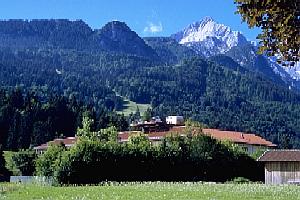
| Garmisch-Partenkirchen, Germany
The picture to the left shows the Fraunhofer Institute for Atmospheric Environmental Research (abbreviated "IFU") in Garmisch-Partenkirchen, where my UV-career began. The mountain in the background is the Alpspitze and I had a great view from my office on this gorgeous summit. The white container on the roof platform of the institute houses the "Stationary IFU Spectroradiometer". Its operation started in 1994 after it had been developed by my colleagues and me. Since then, one solar spectrum is obtained approximately every 10 minutes. Most of my work, however, is based on the "Mobile IFU Spectroradiometer", which has also been developed at the institute. This is the instrument I was traveling with. The institute also hosted several measurement campaigns with national and international contribution and I have been involved in the evaluation of the data. A European intercomparison of UV spectroradiometers was organized in 1993 and in 1994, a similar campaign was arranged with groups from Australia, New Zealand and the United States. A further campaign in 1994 was dedicated to investigations on the change of UV radiation with altitude. In 1997, all groups that are involved in UV measurements in Germany were brought together.
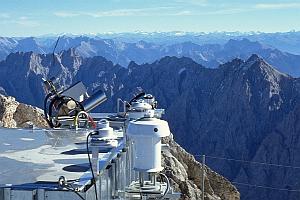
Zugspitze, Germany
| The third UV spectroradiometer developed at IFU is located on top of Germany's highest mountain, the Zugspitze. The landmark is only about 8 kilometers away from the institute. The close neighborhood of two high-quality instruments in different altitudes is unique in the world and was the stimulus of several research projects. For example, by comparing measurements from the instrument on top of Zugspitze with results from its twin in the valley the change of UV radiation with altitude was investigated. The influence of clouds and smog below the summit on UV levels was analyzed in a similar fashion. I was involved both the deployment and support of the "Zugspitze spectroradiometer". 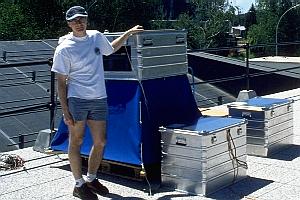
Ispra, Italy
| In spring 1994, I participated with the "Mobile IFU Spectroradiometer" in a European UV instrument intercomparison, which took place in Ispra, Italy. On the picture I am standing next to the spectroradiometer. Its main part is hidden under the blue tent and the box on top houses electronics and data acquisition. The building is on the campus of the "Joint Research Centre",which is a huge research facility funded by the European Commission and idyllically situated next to Lago Maggiore in northern Italy. 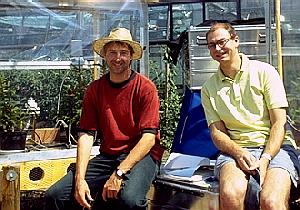
Garmisch-Partenkirchen, Germany
| In summer 1995, I was helping my colleague and friend Hartmut Panten to characterize the radiation environment in small green houses, which were put up in the backyard of IFU. The Mobile IFU Spectroradiometer is behind me on the right side. When you look closely you can spot some spruce trees in the green house behind my friend. There were two sorts of chambers: One group was equipped with a special foil, which blocked short-wave UV radiation. The walls of the second group was translucent to these high-energy solar rays. The goal of the research study was to investigate the impact of short-wave UV radiation on spruce tree by comparing the difference in growth in both chambers. The experiment was part of a concept study leading to larger and fully air conditioned green houses, which were put on top of the mountain Wank in 1997 (see below). 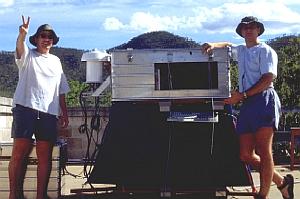
Townsville, Australia
| Between December 1995 and January 1996, I was with the Mobile IFU Spectroradiometer in Townsville. The city is located at the coast of Queensland, the north-easterly region of Australia. The picture shows me with my colleague Aurel Moise from the James Cook University, where the campaign took place. Our goal was to quantify the prevailing UV levels in the tropics of Australia. We found that during summer months, the average daily dose of sunburning UV radiation is about 70% higher in Townsville than in Garmisch-Partenkirchen. This partly explains why the skin cancer rates in Australia are the highest in the world. It is therefore a good idea to always wear a hat, as we do on the photo. 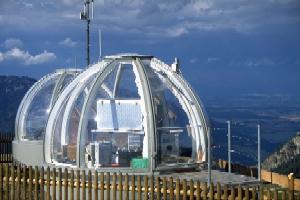
Wank, Germany
| The Wank is one of mountains surrounding Garmisch-Partenkirchen. The two futuristically looking buildings are green houses, which are located close to the Wank's summit in 1800 meter altitude. They serve the same purpose as their precursors mentioned above: The walls of one chamber block UV radiation, whereas the second chamber is translucent. Before spruce and oak trees were put in I was comparing the radiation levels of both chambers with the IFU spectroradiometer. The houses have a roundish shape to withstand up to two meters of snow during winter. They were put on top of a mountain because UV radiation increases with altitude. When ozone depletion gets worse similar UV levels may be expected at ground level that are now observed in higher altitudes. The experimental setup therefore allows to simulate effects of future UV levels on trees. 
Nea Michaniona, Greece
| In 1997, the largest European intercomparison campaign of UV spectroradiometers ever organized was held in Nea Michaniona. The small city is located in the northern part of Greece, close to Thessaloniki. A total of 19 groups participated. I took part with Mobile IFU Spectroradiometer. The photo shows the set up next to the sea. 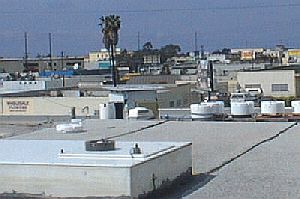
San Diego, USA
| In October 1998, I left the Fraunhofer Institute in Garmisch-Partenkirchen and joined Biospherical Instruments Inc. in San Diego. The picture shows a part of the company's roof platform with the upper part of a SUV-100 spectroradiometer in the foreground. Only the entrance optics (the black ring with a white spot in the middle) penetrate the roof. The instrument measures a solar UV spectrum every 15 minutes. The same type of instrument is also used at the other sites of the UV monitoring network operated by Biospherical instrument. 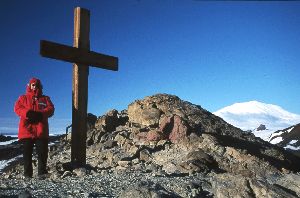
McMurdo, Antarctica
| In January 1999, I was visiting the NSF network site in McMurdo at the edge of the Ross Ice Shelf in Antarctica. The photo shows me standing next to a cross commemorating Captain Scott and his party who lost their lives on the return journey from the South Pole in 1912. The cross is erected on Observation Hill above McMurdo. In the background is Mount Erebus. It is the only active vulcano in Antarctica and almost 3800 meter high. My red parka is part of the Extreme Cold Weather gear, which you need when visiting Antarctica. Temperatures can drop down to -70 ºC. Pictures from my 1999 travel are here. I visited McMurdo again for two weeks in January 2000 after I returned from the South Pole, and for one week in January 2002. Stories and pictures can be found here. 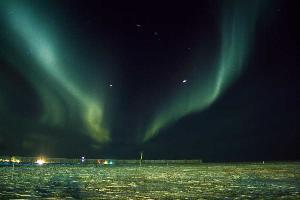
Barrow, Alaska
| In November 1999, I serviced with a colleague the NSF network instrument in Barrow, Alaska, the northern most point of the U.S. At the last day we had the luck of observing a great Aurora. The picutre to the left shows one example. More pictures are here. 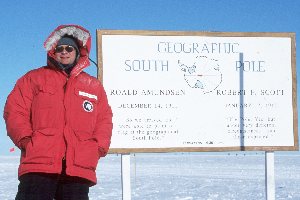
South Pole, Antarctica
| One of my most exciting trips were the visits to Amundsen-Scott South Pole Station in 2000 and 2002. The photo shows me next to the board commemorating Roald Amundsen and Robert F. Scott who were the first men who reached with their expeditions this remote place. In fact, it was a competition between these ambitious men. Amundsen arrived about four weeks before Scott and made it back home in safety. Scott was incredible disappointed that Amundsen had beat him, he and his party got trapped in a terrible blizzard on their way back and all men perished. Today, travel to South Pole with Hercules LC-130 aircrafts is comparatively save but it is still a long way to go; it's about eleven hours flight-time from New Zealand via McMurdo. During my two-week stay in 2000, the weather was mostly sunny and temperatures were usually between -30ºC and -40ºC. If there is no wind, these low temperatures feel surprisingly warm, partly because the air is so dry and thin (the altitude of South Pole is about 3000 meters). Amundsen-Scott South Pole Station is manned with up to 220 people during summer months and approximately 40 - 50 folks stay over the long and cold Polar Night. More pictures from my trips to the South Pole are here. 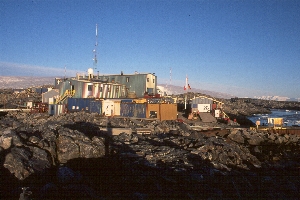
Palmer Station, Antarctica
| In March 2000, I went to Palmer Station on Anvers Island, which is located west of the Antarctic Peninsula, opposite of Chile. Palmer Station is the smallest outpost of the U.S. Antarctic Program, operated year-round with a maximum crew of 45 people. It is surrounded by small islands, all crowded with penguins, sea birds and other wild life during most part of the year. The station lies at the foot of a glacier, which provides awesome vistas. Like on my previous visits to Barrow, McMurdo, and South Pole, I serviced, upgraded, and calibrated one of NSF instruments during my stay. More pictures from Palmer Station, icebergs, and the glacier in the backyard can be found here. |